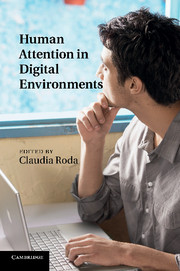1 - Introduction
Published online by Cambridge University Press: 04 February 2011
Summary
In recent years it has been increasingly recognized that the advent of information and communication technologies has dramatically shifted the balance between the availability of information and the ability of humans to process information. During the last century information was a scarce resource. Now, human attention has become the scarce resource whereas information (of all types and qualities) abounds. The appropriate allocation of attention is a key factor determining the success of creative activities, learning, collaboration and many other human pursuits. A suitable choice of focus is essential for efficient time organization, sustained deliberation and, ultimately, goal achievement and personal satisfaction. Therefore, we must address the problem of how digital systems can be designed so that, in addition to allowing fast access to information and people, they also support human attentional processes. With the aim of responding to this need, this book proposes an interdisciplinary analysis of the issues related to the design of systems capable of supporting the limited cognitive abilities of humans by assisting the processes guiding attention allocation. Systems of this type have been referred to in the literature as Attention-Aware Systems (Roda and Thomas 2006), Attentive User Interfaces (Vertegaal 2003) or Notification User Interfaces (McCrickard, Czerwinski and Bartram 2003) and they engender many challenging questions (see, for example, Wood, Cox and Cheng 2006).
- Type
- Chapter
- Information
- Human Attention in Digital Environments , pp. 1 - 8Publisher: Cambridge University PressPrint publication year: 2011
References
- 1
- Cited by



